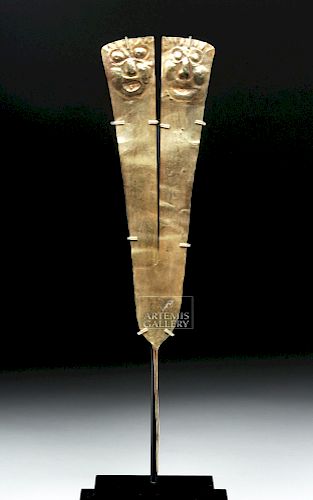Huari 16K Gold Double Plume - Two Faces
Lot 29a
About Seller
Artemis Gallery
686 S Taylor Ave, Ste 106
Louisville, CO 80027
United States
Selling antiquities, ancient and ethnographic art online since 1993, Artemis Gallery specializes in Classical Antiquities (Egyptian, Greek, Roman, Near Eastern), Asian, Pre-Columbian, African / Tribal / Oceanographic art. Our extensive inventory includes pottery, stone, metal, wood, glass and textil...Read more
Estimate:
$5,500 - $8,000
Absentee vs Live bid
Two ways to bid:
- Leave a max absentee bid and the platform will bid on your behalf up to your maximum bid during the live auction.
- Bid live during the auction and your bids will be submitted real-time to the auctioneer.
Bid Increments
| Price | Bid Increment |
|---|---|
| $0 | $25 |
| $300 | $50 |
| $1,000 | $100 |
| $2,000 | $250 |
| $5,000 | $500 |
| $10,000 | $1,000 |
| $20,000 | $2,500 |
| $50,000 | $5,000 |
| $100,000 | $10,000 |
| $200,000 | $20,000 |
About Auction
By Artemis Gallery
May 10, 2018
Set Reminder
2018-05-10 10:00:00
2018-05-10 10:00:00
America/New_York
Bidsquare
Bidsquare : Fine Ethnographic / Asian / Ancient Art
https://www.bidsquare.com/auctions/artemis-gallery/fine-ethnographic-asian-ancient-art-3213
Featuring antiquities from around the world including Pre-Columbian, Tribal, Classical, Asian, so much more! Artemis Gallery info@artemisgallery.com
Featuring antiquities from around the world including Pre-Columbian, Tribal, Classical, Asian, so much more! Artemis Gallery info@artemisgallery.com
- Lot Description
Pre-Columbian, South Coast Peru, Huari/Wari, ca. 700 to 1000 CE. An impressive 16K gold tupu, a pin used to close a tunic, made for hammered 16K gold sheet and depicting a double plume with visages (either zoomorphic or anthropomorphic) comprised of repousse features - round eyes, full noses, open mouths, puffy cheeks, and fringes of straight bangs. Red cinnabar was rubbed into the recesses, providing a wonderful contrast that brings out the details. Size: 10.75" H (27.3 cm); 12.125" H (30.8 cm) on included custom stand.
Although less well known than their successors, the Inca, the Huari (also spelled Wari) were the first impressive highland power of the Andes - arising in the 6th century CE and surviving until the 10th century. The people were named for their ancient capital, which is located about 10 kilimeters north of the present day city of Avacucho. Precious metals were favored by the Huari/Wari peoples, especially when creating articles for the tombs of elite lords. For example, archaeologists have uncovered gold bracelets as well as a silver face mask and breast plate in the royal tomb at Espiritu Pampa. The indigenous metalsmiths also made gold masks and human figures donning characteristic Wari clothing (tunics and four-cornered hats) out of hammered precious metals.
Provenance: private Hawaii, USA collection; ex Ian Arundel, California, USA; ex Colin Arundel, California, USA
All items legal to buy/sell under U.S. Statute covering cultural patrimony Code 2600, CHAPTER 14, and are guaranteed to be as described or your money back.
A Certificate of Authenticity will accompany all winning bids.
We ship worldwide and handle all shipping in-house for your convenience.
#132585Slight surface wear and waviness in areas. Generally excellent.Condition
- Shipping Info
-
All shipping is handled in-house for your convenience. Your invoice from Artemis Gallery will include shipping calculation instructions. If in doubt, please inquire BEFORE bidding for estimated shipping costs for individual items.
-
- Buyer's Premium



 EUR
EUR CAD
CAD AUD
AUD GBP
GBP MXN
MXN HKD
HKD CNY
CNY MYR
MYR SEK
SEK SGD
SGD CHF
CHF THB
THB















